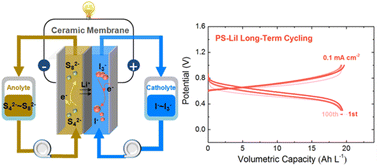High-capacity polysulfide–polyiodide nonaqueous redox flow batteries with a ceramic membrane†
Abstract
Nonaqueous redox flow batteries (NRFBs) have been regarded as promising large-scale electrochemical energy storage technology due to the wider solvent stable potential windows and greater selection of materials. However, the application of NRFBs is greatly limited considering the low capacity and high cost of active materials. In this work, we design and demonstrate a high-capacity polysulfide (PS)–polyiodide (PI) NRFB in Li-ion based 1,3-dioxolane (DOL) and 1,2-dimethoxyethane (DME) (v/v ∼ 1 : 1) organic electrolyte. The high solubility and low cost of PS (5 M) and PI (4 M) can achieve the high capacity and high applicability of NRFBs, which is attractive for realizing large-scale stationary energy storage. The highest volumetric capacity of 28 Ah L−1 based on a full cell is achieved with 1.5 M PS-4 M PI. The high coulombic efficiency (∼100%) and capacity retention (>99%) for 100 cycles in the PS–PI system is demonstrated by using a Li-ion conducting ceramic membrane. Voltage control is applied for both PS and PI to avoid the formation of irreversible solid Li2S and I2, which ensures the high stability of battery reaction. In situ UV-vis spectroscopy reveals the high reversibility of PS and PI in DOL/DME. A continuous flow mode test of the PS–PI system is also demonstrated to realize >300 hours stable cycling performance which implies good applicability for a long-term process. The successful demonstration of this high-capacity PS–PI nonaqueous system provides a new direction to promote the application of NRFBs in more fields.



 Please wait while we load your content...
Please wait while we load your content...